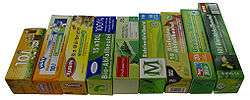Bin bag


A bin bag or bin liner (British English) or garbage bag, or trash bag (American English) is a disposable bag used to contain rubbish (British English), or the North American equivalent trash or garbage. Such bags are useful to line the insides of waste containers to prevent the insides of the receptacle from becoming coated in waste material. Most bags these days are made out of plastic, and are typically black in color.
Plastic bags are a convenient and sanitary way of handling garbage, and are widely used. Plastic garbage bags are fairly lightweight and are particularly useful for messy or wet rubbish, as is commonly the case with food waste, and are also useful for wrapping up garbage to minimize odour. Plastic bags are often used for lining litter or waste containers or bins. This serves to keep the container sanitary by avoiding container contact with the garbage. After the bag in the container is filled with litter, the bag can be pulled out by its edges, closed, and tied with minimal contact with the waste matter.
Created in 1950, this invention can be attributed to Canadians Harry Wasylyk, Larry Hansen and Frank Plomp.[1] In a special on CBC television, the green garbage bag ranked 36th among the top 50 Canadian inventions.[2]
Plastic bags can be incinerated with their contents in appropriate facilities for waste-to-energy conversion. They are stable and benign in sanitary landfills; some are degradable under specified conditions.
Description
Plastic bags for rubbish or litter are sold in a number of sizes at many stores in packets or rolls of a few tens of bags. Wire twist ties are sometimes supplied for closing the bag once full. Varying thicknesses are commonly manufactured - thicker bags are used for heavy duty applications such as construction waste, or in order to be able to withstand being compacted during recycling processes. In the mid-1990s bin bags with draw strings for closure were introduced. Some bags have handles which may be tied, or holes through which the neck of the bag can be pulled. Most commonly, the plastic used to make bin bags is the rather soft and flexible LDPE (Low Density Polyethylene) or, for strength, LLDPE (Linear Low Density Polyethylene) or HDPE (High Density Polyethylene) are sometimes used.
Biodegradable plastic bags


Oxo-biodegradable plastic bags have the same strength as ordinary plastic and cost very little extra. They will degrade then biodegrade if they get into the open environment, but they can be recycled if collected during their useful life. They are designed so that they will not degrade deep in landfill and will not therefore generate methane. Oxo-biodegradable plastic does not degrade quickly in low temperature "windrow" composting, but it is suitable for "in-vessel" composting at the higher temperatures required by the animal by-products regulations. Oxo-biodegradable plastic is bio-assimilated by the same bacteria and fungi, which transform natural material such as twigs and leaves to cell biomass, like lignocellulosic materials. Oxo-biodegradable plastic is designed to degrade initially by a process which includes both photo-oxidation and thermo-oxidation, so it can degrade in the dark. Resin identification code 7 is applicable to biodegradable plastics.
Drawstring and flexibility
In 1984, the drawstring garbage bag was introduced by GLAD[3] and Hefty.[4] In 2001, Hefty introduced a garbage bag with a drawstring designed to stretch around the garbage can's rim and stay in place.[5] In July 2004, ForceFlex, a flexible plastic garbage bag, was introduced by GLAD[3] (followed by Hefty's Ultra Flex brand in September).[6]
See also
- Blue bag
- Packaging
- Plastic bag
- Plastic recycling
- Thermal depolymerization, post consumer waste processing technologies
References
- ↑ "ARCHIVED - Garbage Bag - Incredible Inventions - Cool Canada - Library and Archives Canada". Collectionscanada.gc.ca. Retrieved 2013-08-17.
- ↑ Archived March 10, 2007, at the Wayback Machine.
- 1 2 GLAD ForceFlex Trash Bags end Garbage Gripes, GLAD Press Release Archive, 20 July 2004 (retrieved 21 August 2010)
- ↑ HELPFUL HARDWARE; HELP WITH THE TRASH, Daryln Brewer, New York Times, 27 December 1984 (retrieved 21 August 2010)
- ↑ Pactiv Announces New Hefty The Gripper Waste Bag Patented Stretch & Grip Top Goes on Easy And Stays Put, Pactiv Archived News, 20 August 2001 (retrieved 21 August 2010)
- ↑ Pactiv Announces Hefty Ultra Flex Waste Bags; Thick, strong & stretchable bags respond to consumers' needs, press release, 16 September 2004 (retrieved 21 August 2010 on AllBusiness.com)
Books
- Brody, A. L., and Marsh, K, S., Encyclopedia of Packaging Technology, John Wiley & Sons, 1997, ISBN 0-471-06397-5
- Selke, S, Packaging and the Environment, 1994, ISBN 1-56676-104-2
- Selke, S,. Plastics Packaging, 2004, ISBN 1-56990-372-7
| Wikimedia Commons has media related to Waste bags. |